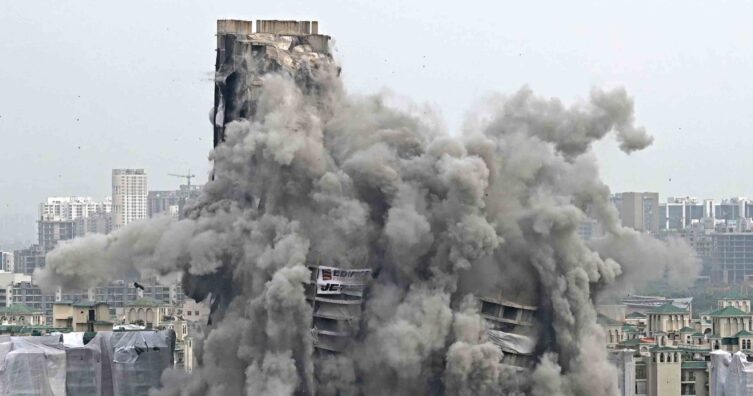With ongoing advancements in science and technology, India’s demolition industry is constantly changing. On August 28th, Noida witnessed a spectacular event in which Mumbai-based Edifice Engineering, with the unwavering support of Noida’s Municipal Authorities, successfully demolished Noida’s Supertech Emerald Towers (Twin Tower), the tallest tower in India that exceeded the permissive construction restrictions. The demolition order came after the Emerald Court’s residents approached Allahabad court in 2012 for illegally constructing ceyane and Apex, Noida’s Twin Tower.
This record-breaking event has left behind an approx 55,000 tonnes of debris, even as some estimates put the figure at 80,000 tonnes. The debris is expected to take an estimated three months to be cleared and disposed of.
Planning the fall
The company spent nine months inspecting the structure and location and analysing the various demolition techniques. Inspections such as the structure’s proximity to its surroundings, available surrounding space, whether the equipment can reach and be placed at a demolition site, and calculating the entire process in the allotted time were planned.
More than 3,500 kg of explosives were placed in over 9,000 holes to bring down two high-rise buildings. After two months of planning and overcoming major challenges, such as the pipeline and structure being located by the roadside, India’s largest benchmark demolition was completed. This demolition project was insured for ₹ 100 crores in total. Giving a perspective on the demolition industry, company spokesperson Mehta said, “The demolition industry is largely an unorganised sector. A player from an organised party carries out demolition
keeping the interest of scrap material rather than how to get down a building safely.” Things have started improving in this industry in the last 15 years.
Safe execution
During the time of fall around 500 police and traffic personnel besides the Provincial Armed Constabulary (PAC) were deployed as the area around Supertech’s twin towers here was put out of bounds for civilians ahead of Sunday’s planned demolition of the structures. All the housing societies in the adjacent area were evacuated in the process and road diversions were put in early in the morning.
Ritu Maheshwari, CEO of Noida Authority, told the media that the demolition was successful because it didn’t impact any neighbouring housing societies. He said that mechanical sweeping machinery, water tanks and smoke guns would be put to aid in the cleaning procedure. Additionally, she said that the location would receive assistance from the Noida Authority’s cleanliness staff.
Managing the demolition debris
Out of total debris, 40 to 50,000 tonnes would go into the pit in the basements and the balance would be disposed of at the CND waste plant by the Noida authorities.
According to Noida planning authorities, 21,000 cubic metres of debris will be transported to and dumped at an isolated location within the city’s Work Circle 7 limits. The remaining waste will be disposed of at the site of the twin towers, where a pit has been dug to bury or store the debris.
A portion of the waste will almost certainly be transported to the Noida Authority’s construction and demolition waste management plant in Sector 80. This plant has a daily capacity of 300 tonnes. It is unknown whether the rubble will be processed at this location.
At least 4000 tonnes of iron and steel are expected to be recovered from the wreckage, which Edifice will use to offset some of the demolition costs.
Cookie Consent
We use cookies to personalize your experience. By continuing to visit this website you agree to our Terms & Conditions, Privacy Policy and Cookie Policy.


















